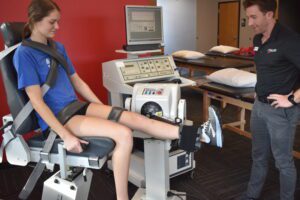Playing pickleball puts a lot of strain on your knees. Whether sprinting to the net, making quick side-to-side movements, or jumping for a shot, your knees absorb much impact. One common issue pickleball players face is patellofemoral dysfunction—a condition where the kneecap (patella) and the immediate surrounding area develop pain.
This pain is often related to the kneecap movement in the groove of the thigh bone and with the loading of the joint, such as during squatting, jumping, and running. However, patellofemoral dysfunction can be painful when sitting for a long time. But don’t worry, knee pain doesn’t have to stop you from playing!
How Your Knee Works and Common Injuries in Pickleball
Your knee has two main joints:
- Patellofemoral joint: This is where your kneecap meets your thigh bone.
- Tibiofemoral joint is the main knee joint, where your thigh bone meets your shinbone.
In pickleball, you can injure both joints. The larger tibiofemoral joint can suffer from sprained ligaments or damaged cartilage. However, patellofemoral dysfunction, which affects the kneecap, is often caused by muscle imbalances or poor movement habits. These issues can be corrected with the right exercises and treatments.
What Causes Patellofemoral Dysfunction in Pickleball?
- Too much stress on the kneecap: The repetitive movements in pickleball—like quick stops, starts, and jumps—can put extra pressure on your kneecap.
- Improper tracking of the kneecap: Sometimes, it doesn’t move smoothly in its groove, causing pain and irritation.
It is important to note that there is typically a lack of identifiable injury or tissue problems with patellofemoral pain despite it being often quite painful.
When Should You Seek Help?
Seeing a healthcare provider is a good idea if you feel pain in the front of your knee, making it hard to play pickleball or do everyday activities. A physical therapist can check the strength of the muscles around your knee and hip, watch how you move when you squat, run, and jump, and look for other issues that could be causing your knee pain.
How to Treat Patellofemoral Dysfunction for Pickleball Players
- Strengthening Exercises: Building balanced strength in the muscles around your knee and hip is important. Stronger muscles on the front and back of your legs help reduce the stress on your knee.
- Stretching: Flexibility is key. Specific stretches can reduce tightness in the knee joint, helping your kneecap move more smoothly.
- Movement Retraining: Pickleball players need to focus on moving correctly to avoid knee pain. Learning proper running, jumping, and squatting forms can help you play without discomfort.
- R.I.C.E. Protocol: If your knee hurts, try the R.I.C.E. method:
- Rest: Take a break from activities that hurt your knee.
- Ice: Apply ice to reduce pain and swelling.
- Compression: Use a bandage to help control swelling.
- Elevation: Keep your leg raised to help reduce swelling.
Extra Support Options
Sometimes, braces or taping techniques can help with patellofemoral dysfunction. For example, Kinesio tape or McConnell taping can help guide the kneecap to move correctly. Some people may also benefit from knee braces with a cutout for the kneecap and extra support on the sides of the knee, though only some need them.
If knee pain keeps you from enjoying pickleball, it might be time to see a physical therapist. They can help you return to the court with less pain and better movement.
All twenty-one Makovicka Physical Therapy clinics offer a Free Injury Screening by appointment. Call the location most convenient, and our experts will assist!

